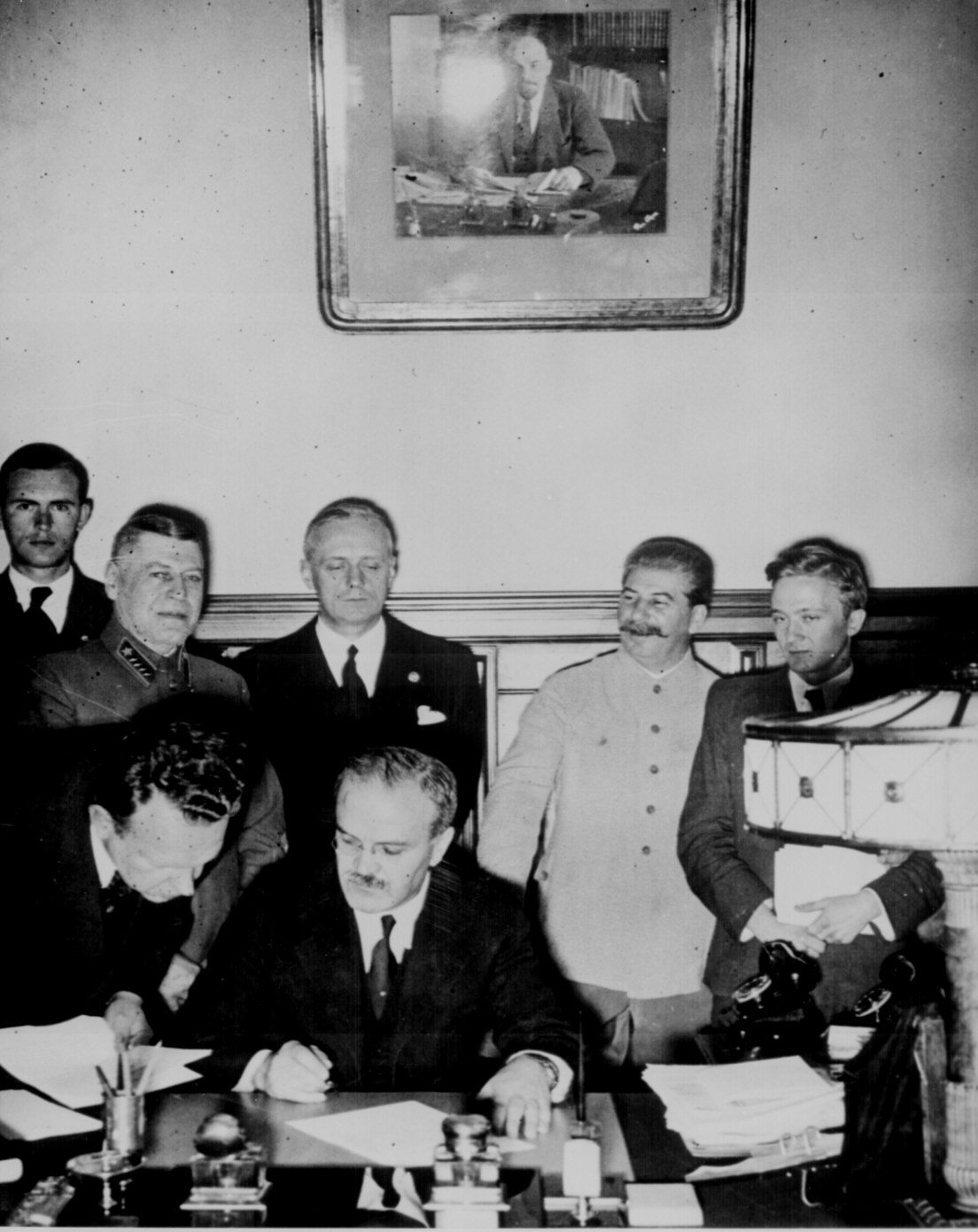World War Two:
The Molotov-Ribbentrop Pact
(Signed August 24, 1939)

The German-Soviet Non-Aggression Pact
Soviet Foreign Commissar Vyacheslav Molotov signs the German-Soviet nonaggression pact; Joachim von Ribbentrop and Josef Stalin stand behind him. Moscow, August 23. 1939. Note the photo of Vladimir Lenin, the founder of the Soviet Union on the wall behind Stalin and Ribbentrop.
The Molotov-Ribbentrop Pact
This treaty between Hitler’s Germany and Stalin’s Soviet Union set the stage for the German invasion of Poland a week later, which was the opening round of World War Two in Europe. Seventeen Days after the German invasion began, the Soviets launched a massive attack on Poland from the east. Poland was divided between the two authoritarian dictatorships. The second part of this treaty remained secret, and called for the division of Eastern Europe between Hitler and Stalin.
Text of the German-Soviet Non-Aggression Pact
The Government of the German Reich and The Government of the Union of Soviet Socialist Republics desirous of strengthening the cause of peace between Germany and the U.S.S.R., and proceeding from the fundamental provisions of the Neutrality Agreement concluded in April, 1926 between Germany and the U.S.S.R., have reached the following Agreement:
Article I. Both High Contracting Parties obligate themselves to desist from any act of violence, any aggressive action, and any attack on each other, either individually or jointly with other Powers.
Article II. Should one of the High Contracting Parties become the object of belligerent action by a third Power, the other High Contracting Party shall in no manner lend its support to this third Power.
Article III. The Governments of the two High Contracting Parties shall in the future maintain continual contact with one another for the purpose of consultation in order to exchange information on problems affecting their common interests.
Article IV. Should disputes or conflicts arise between the High Contracting Parties shall participate in any grouping of Powers whatsoever that is directly or indirectly aimed at the other party.
Article V. Should disputes or conflicts arise between the High Contracting Parties over problems of one kind or another, both parties shall settle these disputes or conflicts exclusively through friendly exchange of opinion or, if necessary, through the establishment of arbitration commissions.
Article VI. The present Treaty is concluded for a period of ten years, with the proviso that, in so far as one of the High Contracting Parties does not advance it one year prior to the expiration of this period, the validity of this Treaty shall automatically be extended for another five years.
Article VII. The present treaty shall be ratified within the shortest possible time. The ratifications shall be exchanged in Berlin. The Agreement shall enter into force as soon as it is signed.
[The section below was not published at the time the above was announced.]
Secret Additional Protocol.
Article I. In the event of a territorial and political rearrangement in the areas belonging to the Baltic States (Finland, Estonia, Latvia, Lithuania), the northern boundary of Lithuania shall represent the boundary of the spheres of influence of Germany and U.S.S.R. In this connection the interest of Lithuania in the Vilna area is recognized by each party.
Article II. In the event of a territorial and political rearrangement of the areas belonging to the Polish state, the spheres of influence of Germany and the U.S.S.R. shall be bounded approximately by the line of the rivers Narev, Vistula and San.
The question of whether the interests of both parties make desirable the maintenance of an independent Polish States and how such a state should be bounded can only be definitely determined in the course of further political developments.
In any event both Governments will resolve this question by means of a friendly agreement.
Article III. With regard to Southeastern Europe attention is called by the Soviet side to its interest in Bessarabia. The German side declares its complete political disinteredness in these areas.
Article IV. This protocol shall be treated by both parties as strictly secret.
Moscow, August 23, 1939.
For the Government of the German Reich v. Ribbentrop
Plenipotentiary of the Government of the U.S.S.R. V. Molotov
Source:
